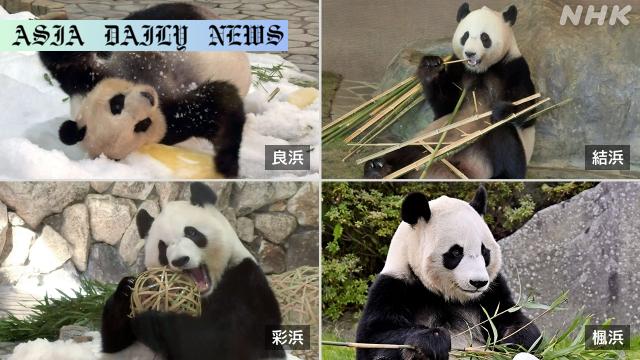giant pandas to return to China as joint conservation program ends in August, marking the end of an era for Wakayama park.
giant pandas in Wakayama will move to China in June 2024.
Ending a three-decade panda conservation project in Japan.
All 4 pandas were born and raised in Adventure World.
China maintains ownership of all pandas worldwide.

The Historic Journey of Wakayama’s Giant Pandas
The announcement that Adventure World in Shirahama Town, Wakayama, Japan, will bid farewell to its four beloved giant pandas has reverberated with nostalgia and sentiment. These pandas, Rauhin (24), Yuihin (8), Saihin (6), and Fuhin (4), have been cherished by visitors and conservationists for decades. All four pandas were born in Adventure World and became symbols not only of wildlife conservation but also of Japan’s warm connection with these remarkable creatures. This transition will mark an emotional milestone for the theme park and its visitors, as these pandas are set to depart for China in late June 2024.
The Context Behind the Departure
Adventure World’s decision follows the expiration of a panda conservation agreement with China, which has guided this joint partnership since 1994. Over a span of three decades, the theme park took pride in hosting and raising 17 pandas, becoming a hub of successful breeding and conservation. However, like all pandas residing outside of China, these cherished animals are technically on loan, and their return signifies adherence to the agreement terms. The transfer to Sichuan Province, specifically to China’s panda research base, is a measured decision, aiming to support panda studies, breeding, and conservation efforts under optimal climatic conditions.
Reflecting on Three Decades of Conservation Success
Since the initiation of the joint conservation project in 1994, Adventure World has become an indispensable contributor to global panda conservation efforts. The park has witnessed the birth of 17 pandas, a feat underscoring the success of its breeding programs. Over the years, these pandas have captivated millions of visitors while raising awareness about their endangered status. The park’s deep-rooted commitment to sustainability has not only enhanced panda populations but also fostered international dialogue on wildlife preservation. Despite the project’s conclusion, the legacy of these efforts will likely inspire further initiatives in giant panda conservation worldwide.
The Future: Hope, Continuity, and Advocacy
Although Adventure World bids farewell to its treasured pandas, the spirit of collaboration and dedication continues. Park management has expressed their hope to negotiate future conservation projects with Chinese authorities, ensuring that their commitment to preserving these majestic animals remains steadfast. Meanwhile, for visitors and panda enthusiasts, this marks an opportunity to rally greater advocacy for wildlife conservation. Emphasizing education, public engagement, and further strengthening international partnerships can help sustain the momentum generated by projects like the one undertaken in Shirahama Town.
Conclusion: A Bittersweet Goodbye
The departure of Rauhin, Yuihin, Saihin, and Fuhin from Adventure World marks the end of an era, yet it signifies a bright future for these pandas as they continue their journey in dedicated research facilities. As they leave for China in late June 2024, their legacy remains engraved in the hearts of those who witnessed their playful antics, nurturing care, and incredible story of survival. This bittersweet chapter highlights the importance of international collaboration in wildlife conservation and reminds us of our collective responsibility to protect and cherish endangered species. While the Wakayama pandas will no longer roam Adventure World, their impact on conservation efforts is both enduring and immeasurable.
Commentary
Reflecting on the Emotional Impact of Conservation Projects
The news of the giant pandas leaving Adventure World brings about a mix of emotions for conservation enthusiasts and wildlife lovers alike. These four pandas, born and nurtured in Japan, symbolize decades of dedication toward preserving one of the planet’s most iconic and endangered species. Their journey back to China is a poignant reminder of the interconnectedness of our efforts and the transient yet impactful role sanctuaries play in wildlife management.
The Importance of International Collaboration
The success of Japan’s panda conservation efforts is a testament to the power of cooperation. The agreement between Adventure World and Chinese authorities has spanned thirty years, underscoring a shared responsibility for biodiversity. As these pandas transition to their new home in China, the need for ongoing collaborations between nations becomes increasingly evident. With habitat destruction and climate change posing threats to wildlife globally, partnerships like these could pave the way for innovative conservation strategies, inspiring other countries to adopt similar approaches.
A Call to Action for Conservation Advocacy
The story of the Wakayama pandas leaves us with a compelling message: conservation is both a privilege and a duty. As these animals leave Japan, they serve as ambassadors for wildlife preservation, urging individuals and organizations to champion sustainability and ecological balance. Whether it’s through education, awareness campaigns, or supporting global sanctuaries, there’s an undeniable need for collective action. The departure of these pandas marks the end of an era, but it also signals the beginning of renewed efforts to protect vulnerable species and habitats worldwide.


